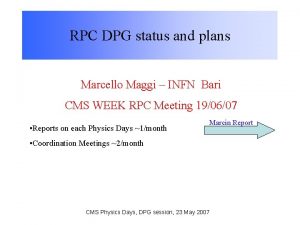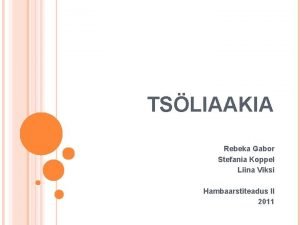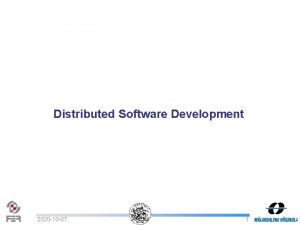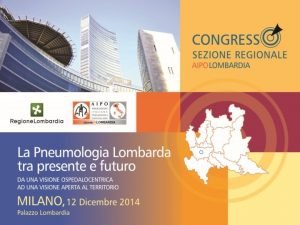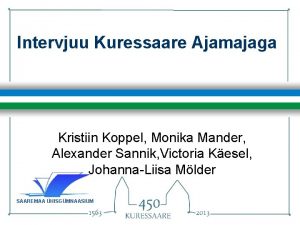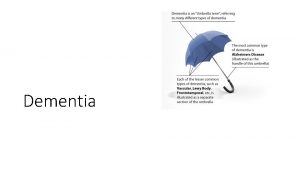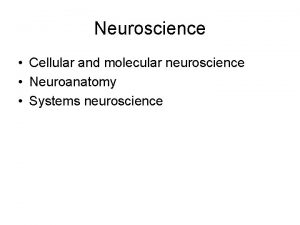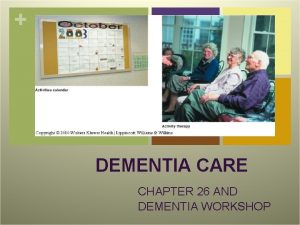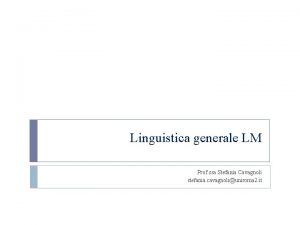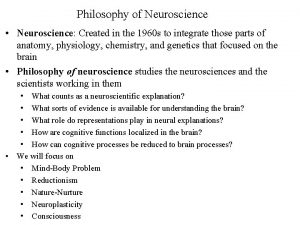Epidemiology of Dementia Stefania Maggi CNRInstitute of Neuroscience
























- Slides: 24

Epidemiology of Dementia Stefania Maggi CNR-Institute of Neuroscience Aging Branch Padova, Italy

Worldwide population 65+ milion The proportion of Older people will Increase from 7% to 12% Source: United Nation, Population Aging and Development, 2009


Worldwide dementia: the numbers will double every twenty years!! Million Ferri et al. , 2005, Lancet 366: 2112 -17

Epidemiology studying dementia Give the real size of dementia: Prevalence 2. Incidence 3. Risk factors 1. 4. Protective factors (biologic, behavioural, socio-economic) Dementia diagnosis!

Diagnosis: Revised criteria NINDS-ADRDA (Mc. Khann, 2011) for all-cause dementia Cognitive or behavioural (neuropsychiatric) symptoms Interfere with work or usual activities Represent a decline from previous functioning levels Are not explained by delirium Cognitive impairment established by objective cognitive assessment, self- and proxy-reported, and finally confirmed by neuropsychological testing Deficits in at least two following domains: Acquire and remember new information Reasoning and handling complex task Poor judgment Visuospatial abilities Language Changes in personality, behaviour, or comportment

Prevalence studies

Worldwide Prevalence of dementia Qiu et al. , 2009, Dialogues. Clin. Neurosci. 11: 111 -128

EURODEM STUDY Kuopio Study (Finland) Kungsholmen Project (Sweden) Odense Study (Denmark) Rotterdam Study (Netherlands) Melton Mowbray (UK) MCR-ALPHA (UK) PAQUID (France) Pamplona Study (Spain) Zaragoza Study (Spain) ZARADEMP (Spain) ILSA (Italy) Mean prevalence of dementia: 6, 4 % 65+ years old

EURODEM STUDY Kuopio Study (Finland) Kungsholmen Project (Sweden) Odense Study (Denmark) Rotterdam Study (Netherlands) Melton Mowbray (UK) MCR-ALPHA (UK) PAQUID (France) Pamplona Study (Spain) Zaragoza Study (Spain) ZARADEMP (Spain) ILSA (Italy)

General Conclusions on Dementia prevalence studies l AD prevalence increases with age doubling every 5 years from age 65 l Prevalence l Need of AD is higher than prevalence of Va. D to better define the “mixed” form of dementia l Trends in prevalence reflects the influence of the incidence of disease and survival l Prevalence and incidence studies based on either hospital records or volunteers underestimate the AD l Poor sensitivity of screening test

Incidence studies

Worldwide dementia Incidence Qiu et al. , 2009, Dialogues. Clin. Neurosci. 11: 111 -128

Per 1000 persons-year EURODEM

General Conclusions on Dementia Incidence studies l Incidence l Female increases by 2 times about every 5 years population has an increased risk of AD l Incidence is influenced by applied diagnostic criteria l Differences among countries are more pronounced for AD and Va. D comparison respect to other forms of dementia

Risk and Protective factors for dementia

Risk Factors l l l l l APOE- 4 allele: susceptibility gene Vascular RF (obesity, high cholesterol) Vascular disease (diabetes, hypertension, TIA, WM lesion) Lifestyle (heavy alcohol intake, smoking) High serum Homocysteine Inflammation Toxic exposure (aluminium, mercury) Traumatic brain injury Depression Protective Factors l l l l Antioxidant (Vitam E and C) High serum levels of folate and Vitamin B 12 Polyunsaturated fatty acid (Omega 3) High education level Social network and engagement Regular physical activity Active mind

Survival of patients with dementia

ILSA S tudy ILSA coorte: dementia vs. non D P<0. 05

Survival in ILSA coorte: disability According to the Global Burden of Disease estimates, dementia Contributes 11. 2% of years lived with disability in people 60+, more than stroke (9. 5%), musculoskeletal ds (8. 9%), CVD (5%), cancer (2. 4%) Demented Non demented P<0. 05

Hazard Ratio and 95% CI of death in the ILSA cohort Noale M et al. Dement geriatr Cogn Disord 2003

I COSTI DELLA MALATTIA DI ALZHEIMER COSTO MEDIO ANNUO : circa 43, 000. 00 Euro (Gambina, et al, 2010) Due studi italiani precedenti (Co. Dem. , Bianchetti 1998; Cavallo e Fattore 1997) calcolavano un valore medio tra i 93 e i 98 milioni.

Epidemiologia della Demenze: conclusioni

l Dementia is a devastating neurodegenerative disorder that will grow up overtime. l Multidisciplinary approches to assess dementia (genetic, epidemiologist, clinicians) l Prevalence and Incidence increase exponentially with age (65 +) worldwide l Take into account Risk and Protective factors l In patients with dementia, a comprehensive approach including any comorbidities may improve the prognosis quoad vitam e quoad valetudinem
 Maggi status
Maggi status Questionnaire on maggi noodles
Questionnaire on maggi noodles Nido de hornero
Nido de hornero Mario maggi andrologo
Mario maggi andrologo Grammage meaning in maggi
Grammage meaning in maggi Stefania xella
Stefania xella Costantini stefania altezza e peso
Costantini stefania altezza e peso Stefania pozio
Stefania pozio Julian tuwim rodzina
Julian tuwim rodzina Stefania parnanzone
Stefania parnanzone Ilmatsalu linnutee
Ilmatsalu linnutee Stefania di pardo
Stefania di pardo Stefania cazzoli
Stefania cazzoli Stefania spagnolo
Stefania spagnolo Stefania lanaro
Stefania lanaro Rebeka gabor
Rebeka gabor Acp programme
Acp programme Stefania pezzetti
Stefania pezzetti Alice koppel
Alice koppel Stefania nencioni
Stefania nencioni Stefania ottaviani
Stefania ottaviani Stefania padoa
Stefania padoa Stefania albertani wikipedia
Stefania albertani wikipedia Kristiin koppel
Kristiin koppel Stefania spagnolo
Stefania spagnolo
